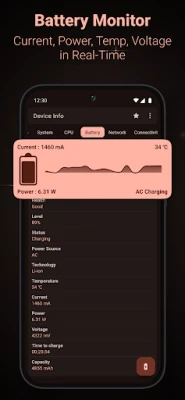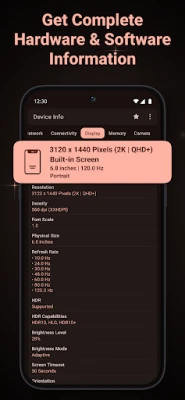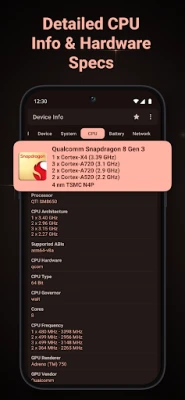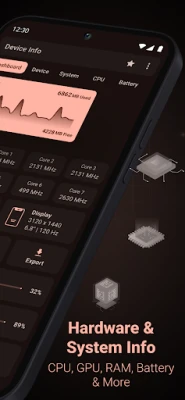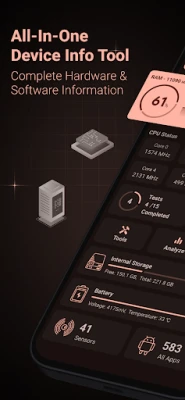
Latest Version
3.3.8.2
December 25, 2024
Yasiru Nayanajith
Tools
Android
0
Free
com.ytheekshana.deviceinfo
Report a Problem
More About Device Info: System & CPU Info
Comprehensive Device Dashboard: Your Ultimate Guide to Software and Hardware Insights
In today's digital age, understanding your device's performance and capabilities is crucial. A well-structured dashboard provides a detailed overview of both software and hardware information, enabling users to optimize their devices effectively. This article delves into the various components of a device dashboard, offering insights into RAM, storage, battery health, CPU performance, and more.
Device Overview: Key Specifications
The Device Overview section presents essential information about your device, including:
- Device Name: The official name of your device.
- Model: The specific model number.
- Manufacturer: The company that produced the device.
- Manufactured Date: When the device was made.
- Device Age: The total time since the device was manufactured.
- IMEI: The unique identifier for mobile devices.
- Hardware Serial: The serial number for hardware identification.
- Network Operator: The service provider for mobile connectivity.
- Network Type: The type of network your device is connected to.
System Information: Understanding Your Operating System
The System Information section provides a comprehensive look at your device's operating system, including:
- OS Version: The current version of the operating system.
- API Level: The level of the application programming interface.
- Security Patch Level: The latest security updates applied.
- Bootloader: Information about the bootloader version.
- Kernel: The core of the operating system.
By keeping track of these details, users can ensure their devices are running the latest software, enhancing security and performance.
CPU Performance: Analyzing Processing Power
The CPU section reveals critical details about your device's processing capabilities:
- System on Chip (SoC): The integrated circuit that houses the CPU and GPU.
- Number of Cores: The total number of processing units available.
- CPU Frequency: The speed at which the CPU operates.
- GPU Renderer: Information about the graphics processing unit.
Understanding CPU performance helps users gauge their device's ability to handle demanding applications and multitasking.
Battery Health: Monitoring Power Efficiency
The Battery section is vital for assessing your device's power management:
- Battery Level: The current charge percentage.
- Battery Status: Whether the battery is charging or discharging.
- Temperature: The current temperature of the battery.
- Voltage: The electrical potential of the battery.
By monitoring these metrics, users can extend battery life and optimize charging habits.
Network Connectivity: Staying Connected
The Network section provides insights into your device's connectivity:
- IP Address: The unique address assigned to your device on the network.
- DNS: The domain name system settings.
- Wifi Standard: The technology standard for wireless communication.
Understanding network connectivity helps users troubleshoot issues and optimize their internet experience.
Display Features: Visual Performance
The Display section outlines the visual capabilities of your device:
- Resolution: The pixel dimensions of the display.
- Refresh Rate: The frequency at which the display updates.
- Brightness: The maximum brightness level of the screen.
These features are essential for users who prioritize visual quality, especially for gaming and media consumption.
Memory Management: Storage Insights
The Memory section details the storage capabilities of your device:
- RAM: The amount of random access memory available.
- Internal Storage: The built-in storage capacity.
- External Storage: Any additional storage options available.
Effective memory management ensures smooth operation and ample space for applications and files.
Sensor Capabilities: Enhancing User Experience
The Sensors section lists the various sensors integrated into your device:
- Accelerometer: Measures device orientation and movement.
- Gyroscope: Provides rotational data for enhanced navigation.
- Proximity Sensor: Detects nearby objects to prevent accidental touches.
These sensors contribute to a more interactive and responsive user experience.
App Management: Optimizing Your Applications
The Apps section offers detailed information about installed applications:
- App Version: The current version of each application.
- Permissions: The access rights granted to each app.
- Activities: The various functions each app can perform.
By analyzing app performance and permissions, users can enhance security and optimize device functionality.
Advanced Tools: Enhancing Device Performance
The Tools section includes features for in-depth analysis:
- App Analyzer: Evaluate app performance and resource usage.
- Wifi Analyzer: Assess nearby wifi networks for optimal connectivity.
- Export Reports: Generate and share detailed reports on
Rate the App
User Reviews
Popular Apps










Editor's Choice












